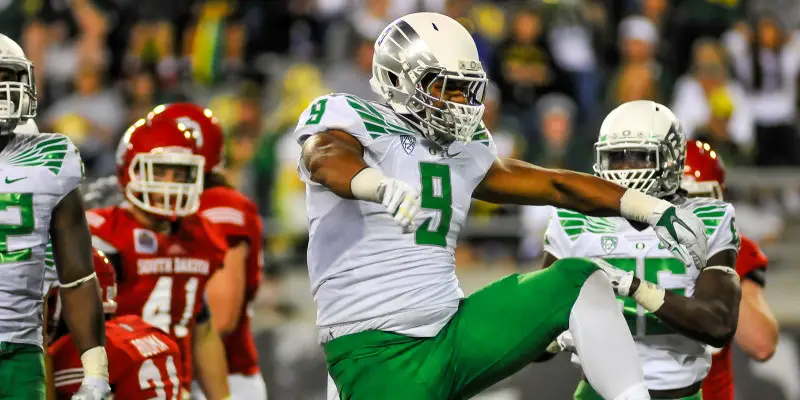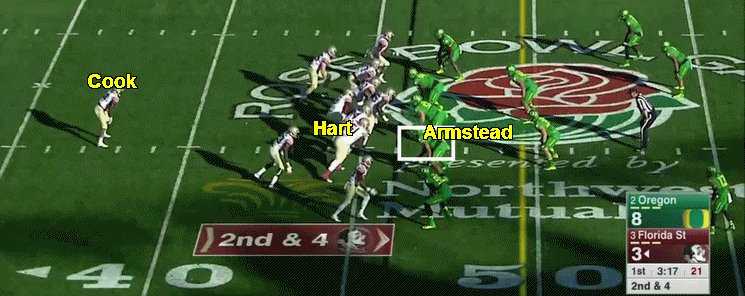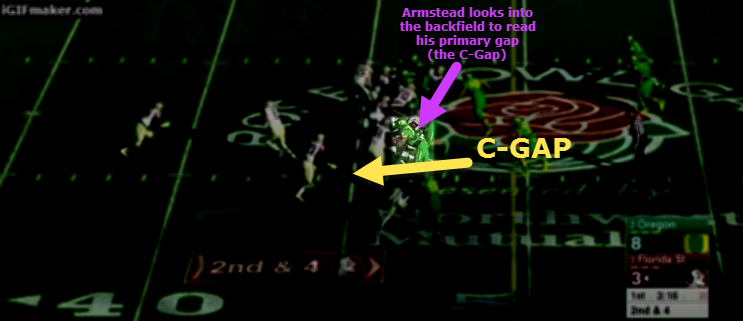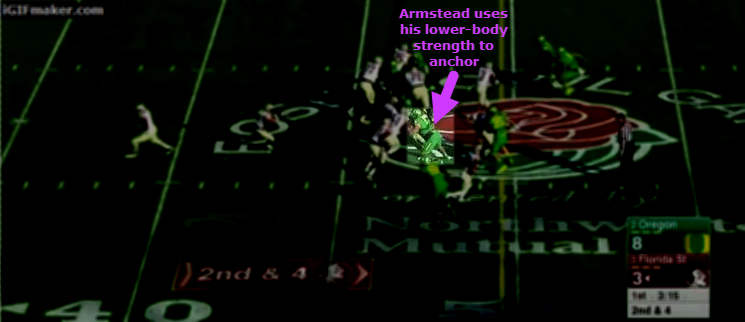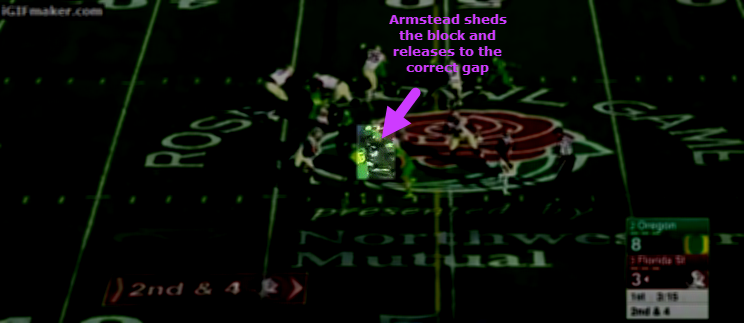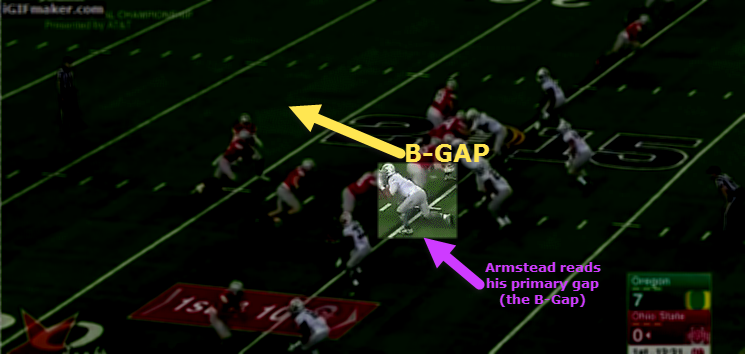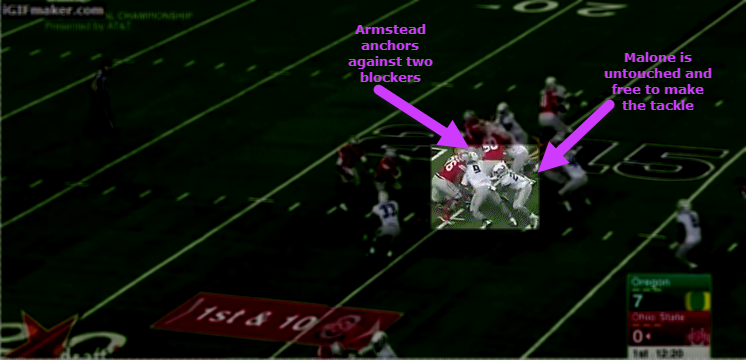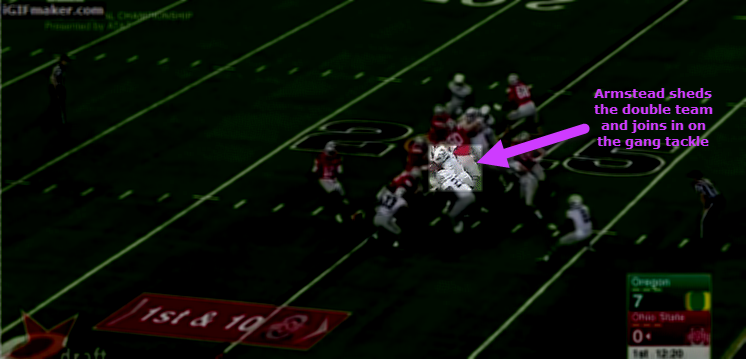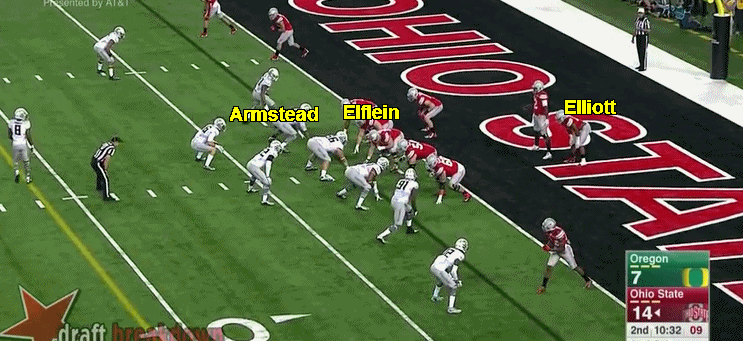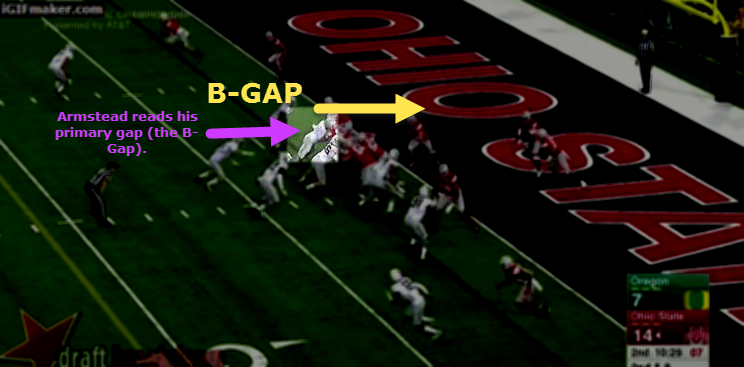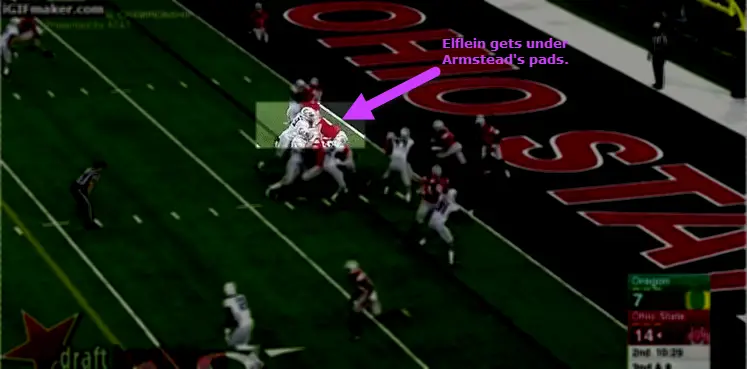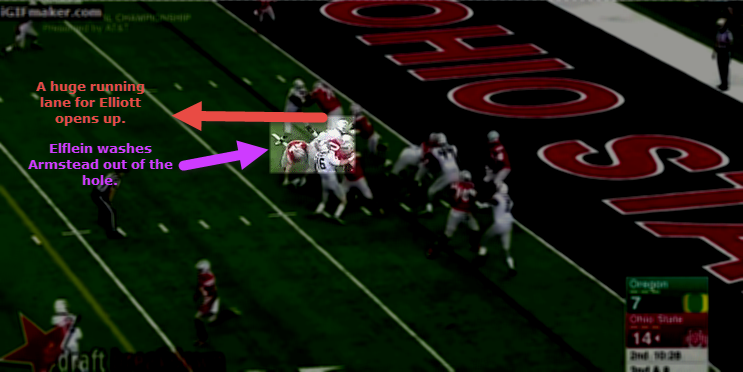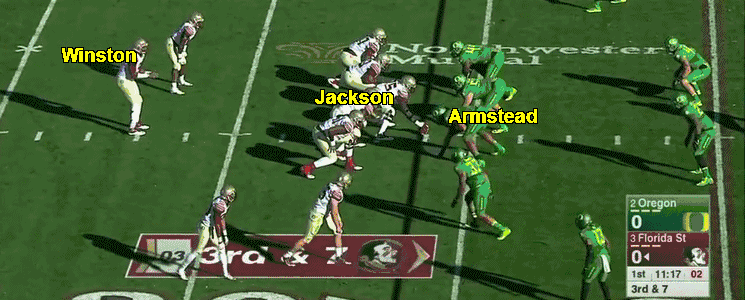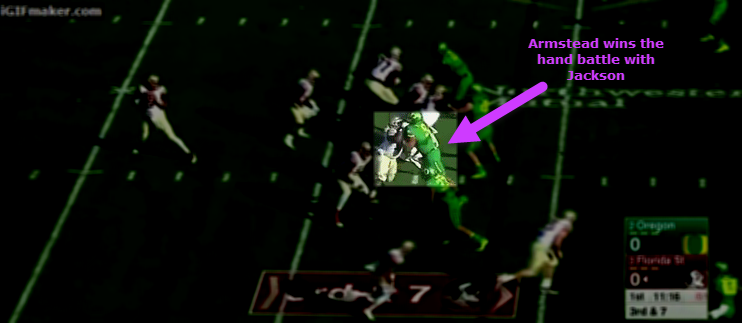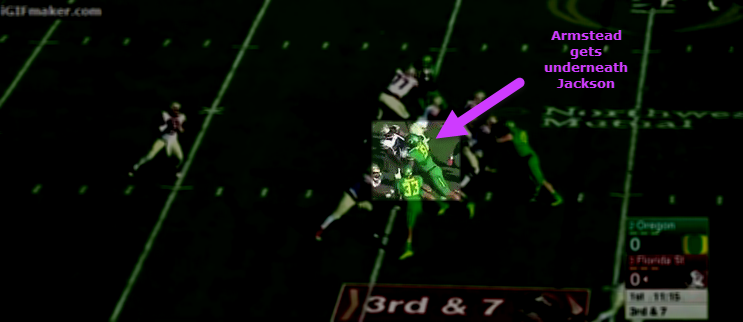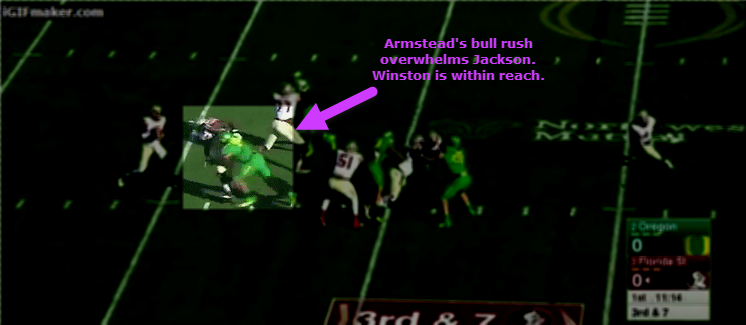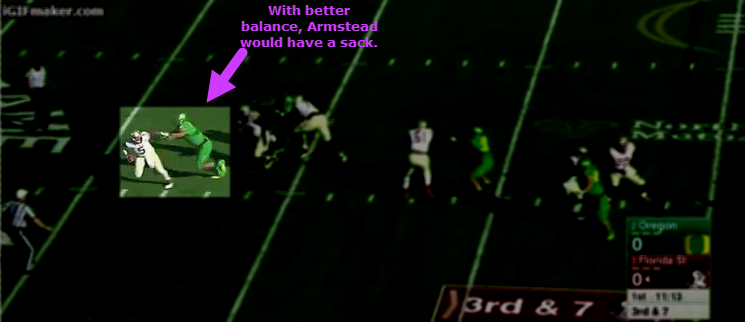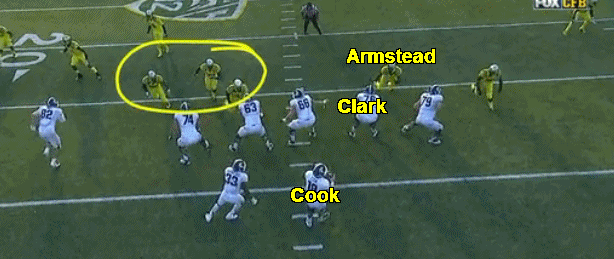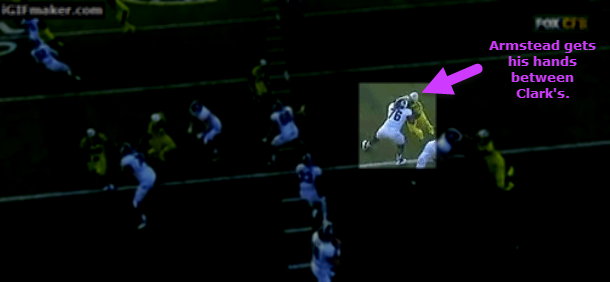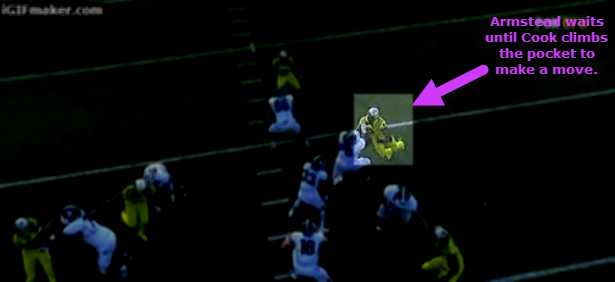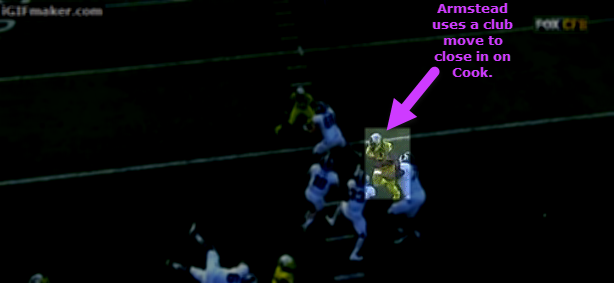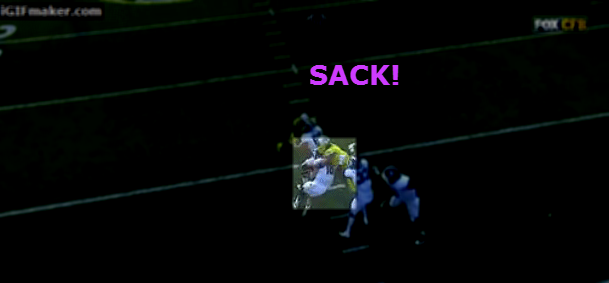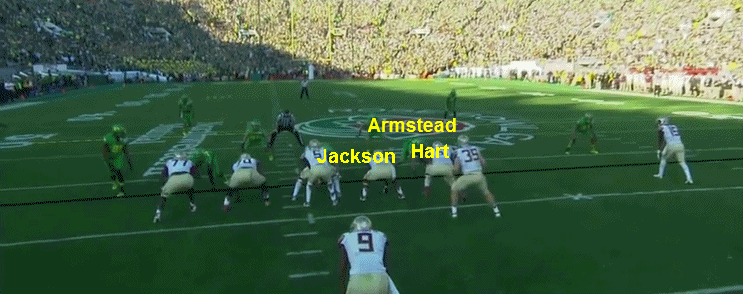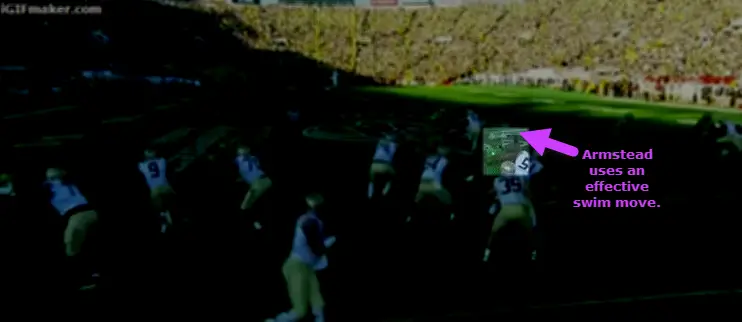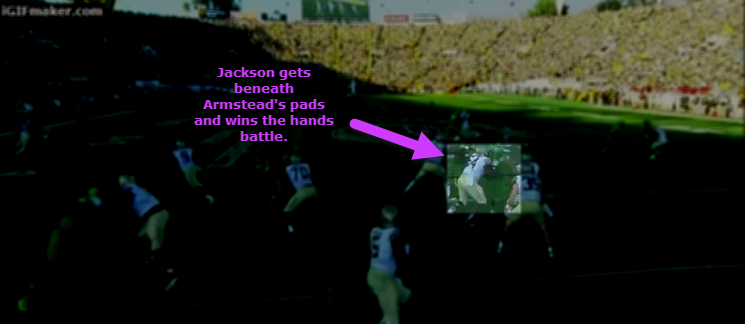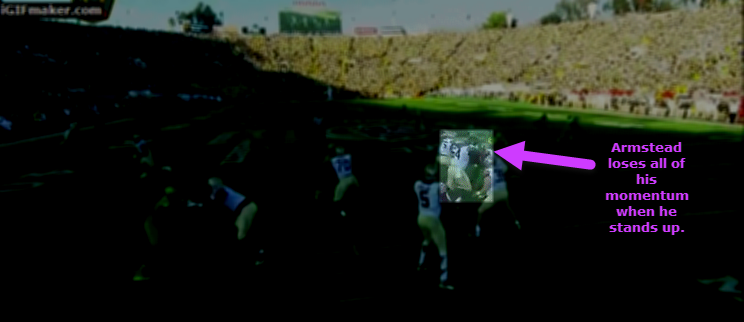It was April 6, 2012. The Oregon Ducks football team had finished a spring practice and defensive line coach Jerry Azzinaro met with OregonLive reporter Aaron Fentress. Fentress was interested in hearing about a heralded four-star high school recruit and incoming freshman: Arik Armstead. Azzinaro quipped, “Arik who?”
It did not take long for Armstead to make a name for himself in Eugene. He earned snaps in the defensive line’s rotation as a freshman. After Azzinaro left for the Philadelphia Eagles, Armstead only improved. His efforts have paid off, as ESPN draft analyst Mel Kiper, Jr. projected the Atlanta Falcons to select him with the eighth overall pick in the 2015 NFL Draft.
What factors should NFL scouts consider when they evaluate Armstead?
Measurables (from the NFL Combine)
Armstead’s greatest physical asset is his exceptional height at 6’7″. Defensive coaches love linemen who can obstruct passing lanes. Yet, Armstead can actually play even taller with a 34″ vertical jump. He showed solid short-range athleticism with an impressive broad jump, 3-cone drill, and 20-yard shuttle.
Run Defense
As a 3-4 defensive end, Armstead must two-gap, repeatedly engaging an offensive lineman and controlling the gap on either side of him. Armstead is superb at absorbing blocks and he rarely gets overpowered by an offensive lineman. He handled a lot of dirty work for the Ducks, absorbing blocks to free up linebackers. This ability does not show up in the SportsCenter Top 10, but defensive coaches love it.
Armstead needs to improve on getting his arms extended and pad level lower. “When you [have] a big strong body like that,” former Oregon defensive coordinator Nick Aliotti said, “once you learn how to get your pads and use your hands underneath that other person’s pads and inside his framework, you’ll be a better player.”
Play 1: 2015 Rose Bowl Game vs. Florida State
On this play (above), Florida State handed the ball to running back Dalvin Cook (No. 4). Armstead used excellent two-gap technique to hold Cook to a short gain.
Armstead (above, No. 9) successfully got his hands on Florida State right tackle Bobby Hart (above, No. 51) and moved his feet laterally.
While Armstead (above) does not fully extend his arms, he keeps Hart from getting leverage on him.
Armstead (above) showed gap discipline, but could have penetrated the backfield if he extended his arms. Regardless, he did a good job in waiting to disengage for the tackle until Florida State running back Dalvin Cook (No. 4) cut to the left.
Play 2: 2015 College Football Playoff National Championship Game vs. Ohio State
This play (above) showcases a quietly impressive effort by Armstead (No. 9). The best thing a two-gapping defensive lineman can do in the run game is free up one of his linebackers to make the stop, which is exactly what happened here.
Armstead (above) began the play by engaging Ohio State right tackle Darryl Baldwin (No. 76).
Armstead (above) not only engaged Baldwin, but also occupied a second blocker as tight end Jeff Heuerman (behind Baldwin, No. 5) attempted to double-team him up to Oregon inside linebacker Derrick Malone (No. 22).
Armstead (above) absorbed the double team, allowing Malone to hit Ohio State running back Ezekiel Elliott (No. 15). Even more impressive, Armstead disengaged from the double team and joined in on making the tackle.
Play 3: 2015 College Football Playoff National Championship Game vs. Ohio State
On this play (above), Armstead (No. 9) struggled because he allowed his pad level to rise. This play is an example of how his height can be used against him.
He successfully got his hands on Ohio State right guard Pat Elflein’s (above, No. 56) pads at the point of attack, where he looked into his primary gap (the left B-gap).
When he saw Elliott (above, No. 15) cut to the inside, Armstead lost his balance, resulting in an elevated pad level.
Armstead (above) lost his initial leverage leverage on Elflein, who took advantage of this opportunity by getting under Armstead’s pads.
Armstead (above) was then washed out of the hole entirely, allowing Elliott to gain 26 yards. Though he is a capable run stuffer, Armstead has some flaws which need to be improved.
Pass Defense
Armstead is not an elite pass-rusher, but he flashes potential. He displays impressive lower-body strength when bull-rushing an offensive lineman. However, Armstead does not just rely on strength alone. He shows good instincts in keeping his eyes in the backfield. NFL coaches will want Armstead to play much lower coming out of his stance. He has neither great speed nor great reflexes, so he generally struggles to pressure the quarterback when blockers exploit his pad level.
Play 4: 2015 Rose Bowl Game vs. Florida State
On this play, Armstead bull rushed Florida State right guard Tre’ Jackson (No. 54), pushing him about seven yards into the offensive backfield.
Armstead (above) initially gained the upper hand using his initial explosion. However, it was more impressive how he used his hands on the inside of Jackson’s pads to sustain his explosiveness throughout the play.
Armstead (above) had so much leverage due to this burst of explosiveness that he knocked Jackson off balance.
As a result, Armstead (above) nearly planted Jackson on the ground.
If Armstead had better body control when he shed the block, he would have sacked Florida State quarterback Jameis Winston (No. 5). Still, he forces Winston to throw the ball away.
Play 5: 2014 Regular Season Week 2 vs. Michigan State
With his team in front just by five points, Armstead made a crucial play from the three-technique alignment (above) which kept Oregon ahead of Michigan State at the end of the third quarter. He ended up taking on Michigan State right guard Donovan Clark (No. 76) and sacked quarterback Connor Cook (No. 18).
Armstead exploded from the three-technique alignment, bull rushing Clark (above).
He got a decent push on Clark (above), but displayed good patience in attacking Cook.
When Cook climbed the pocket, Armstead (above) used a club move to disengage from Clark, moving his body parallel to the line of scrimmage.
He prevented Cook from finding a running lane on the inside and earned a game-changing sack. The Ducks never gave up the lead after Armstead’s sack.
Play 6: 2015 Rose Bowl Game vs. Florida State
On this play (above), Armstead shows a weakness in adjusting to an offensive lineman’s tactics in pass protection. When he fails to gain leverage on a lineman, he often struggles to adapt.
Armstead (above) did a good job of getting his hands on Hart. He then used a nice swim move to disengage from Hart in order to take on Jackson.
Armstead’s (above) pad level at the point of attack was too high, slowing his momentum.
When Hart got his hands under Armstead (above), the Oregon defensive end had no answer. Armstead’s potential was evident here, but he needs more work to become a polished pass rusher.
Conclusion
Many football writers believe Armstead has great potential, but is a risky choice. While this notion has some truth, I think it is exaggerated. Armstead is already a capable two-gap run stuffer. He might always be somewhat currently limited as a pass rusher, but he has potential to improve by leaps and bounds. Armstead should be an effective defensive lineman, regardless of whether he becomes a superstar in the NFL.
I may be in Pennsylvania, but “Oh how we love to learn about your beloved Ducks!”
Joe Kearns
Oregon Ducks and Philadelphia Eagles Football Analyst for CFF Network/FishDuck.com
State College, Pennsylvania
Top Photo by Craig Strobeck
Joe Kearns is a senior at the Pennsylvania State University majoring in Economics. He intends to pursue a career in the banking and financial services industries, but is also a lifelong diehard Philadelphia Eagles fan who enjoys analyzing college and pro football film as a hobby. Along with being a fan, Joe’s football knowledge comes from his days as a center, defensive tackle, and long snapper for his high school in Mt. Lebanon, Pa. Though he is a Nittany Lion, he has taken a great interest in the Oregon football team since Chip Kelly became the Eagles head coach. He loves pancakes ( and not just the breakfast food).

